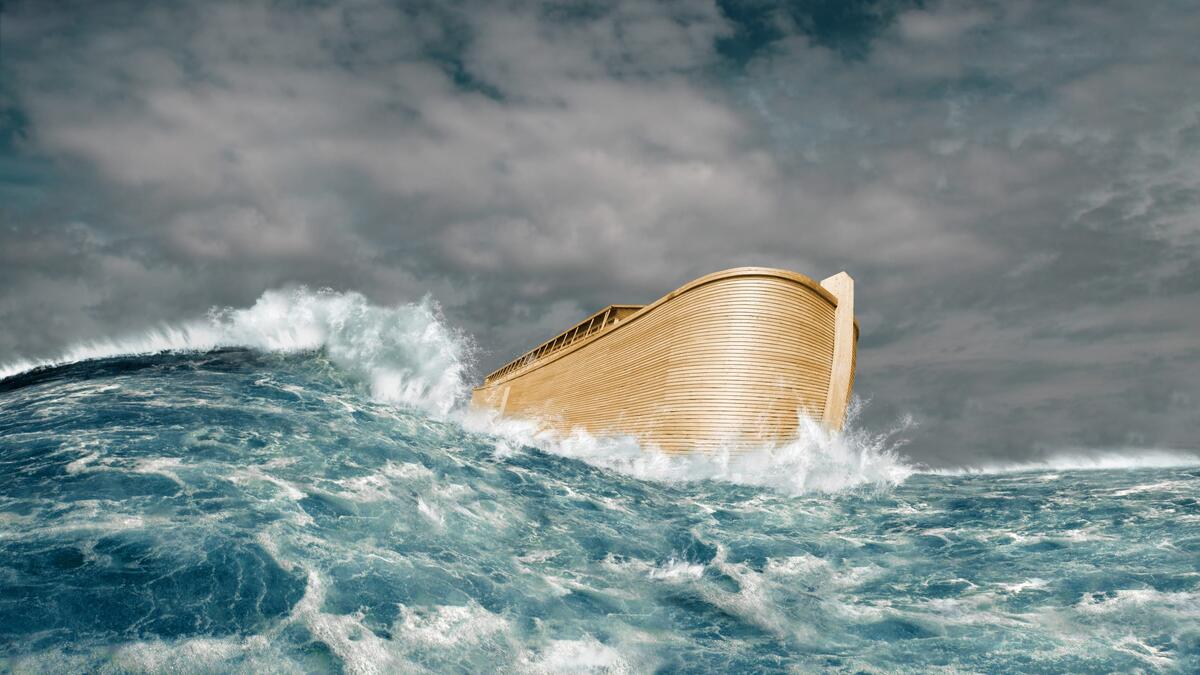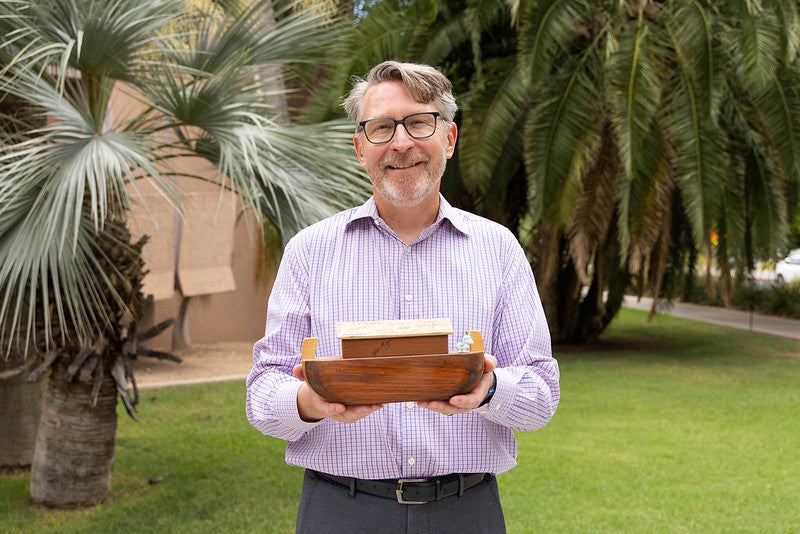Jeffrey Cohen, dean of humanities at The College of Liberal Arts and Sciences at Arizona State University, has always loved researching the topics that intrigue him, from writing on what monsters reveal about the cultures that dream them to the long history of humans using stones as communication devices that cross the ages.
His newest book, “Noah’s Arkive,” came from that same curiosity but also held a powerful meaning.
Co-authored by Cohen and Julian Yates, the book, released in June, examines the legacies of Noah’s Ark and accounts of global warming dating back thousands of years to the present.
Through illustrations from various artists and narratives that span millennia, the book addresses the less familiar stories of the ark, how we think about climate change and “how the story of the ark can frame how we think about environmental catastrophe and refuge, conservation and exclusion, offering hope for a better future by heeding what we know from the past,” the book’s abstract says.
“The book's goal is to make these powerful and forgotten stories of Noah’s Ark better known,” Cohen said. “When it comes to climate catastrophe and climate justice, we too often resign ourselves to loss — and repeat a narrow version of the Noah tale over and over again. We have better versions of the story.”
Cohen spoke with ASU News about the book.
Question: What gave you the idea to write this book?
Answer: I think what happened is that I noticed I had been keeping in an electronic notebook lots of pictures of Noah’s Ark. I became fascinated, especially with medieval manuscript pictures of Noah’s Ark and how many times it was depicted.
I got stuck on the point that so many pictures of Noah’s Ark that seem natural and familiar to us are not in (the book of) Genesis. Because Genesis has a really quick version of Noah’s Ark. You never see people in it. You never see it setting sail. I actually became obsessed. Why is it that from the very first illustrated Bible, the flood is depicted from the point of view of the people who are not on the ark? I really got that stuck in my head.
One inspiration, in particular, is a beautiful medieval illustration in the Walters Museum in Baltimore. William de Brailes drew a picture of the flooded world beneath the ark, an ocean floor containing dead animals, fish and humans in a stack that Noah did not save. That’s not a scene in Genesis; the Bible has nothing to say about the people and animals left behind. We wanted to look further into why the artist focused on the drowned, not the saved — and to see what it means to tell a version of the story Genesis invites but doesn’t contain.
Q: How would you describe what the book is about?
A: I think about it this way: We live in a time of severe climate change, including rising seas. It’s something that we’re all dealing with, and it’s something that is not just in our imagination. It’s in our present reality. And whenever we’re faced with a time of stress, we tend to fall back on narrating it according to the stories that we know.
That story that everybody knows is a story of Noah and his ark. It’s about a family’s survival against anthropogenic climate change. And whether we want to or not, we keep retelling a version of that story every time we imagine what it’s like to survive disaster. If we realize that over history, humans had retold that story in far more complicated ways than we do at this moment, it would open us up to more humane ways of thinking about life during a time of ecological catastrophe.
Q: For the book, you examined hundreds of stories and illustrations about Noah’s Ark. What did you find?
A: We found that most people think they know the story of Noah and his ark, but in fact, they know it from a children’s picture Bible or a children’s play set, and they have no idea of how complicated Genesis is. They don’t realize how many questions people throughout history have had about Noah, especially when it comes to the choices Noah made.
I’m trained as medievalist, where I’ve done a lot of my work in various languages and time periods. One of the things that propels my scholarship is to remind current audiences of things that we used to know in the past and we forgot. It does seem to me that in the past we told far more complicated stories about survival during climate change than the ones we tell now.
So part of the book is to put the complicatedness back and not to tell simplified stories of Noah and his family surviving against climate change, and also not to end the story with a rainbow and happiness and all the animals together. That’s just not the biblical version of the story.
We started researching illustrations of Noah’s Ark in 2015 and created a database of about 300 illustrations, many depicting episodes that aren’t in Genesis. Some, for example, show the ark sailing away while people are drowning. We decided to center the Noah story around stories that spoke to us across the centuries and offered powerful retellings or questioning of a story we already know. We also visited people creating full-scale versions of Noah’s Ark. That’s an incredible undertaking, and we wanted to learn more about why people want to make arks real.
Jeffrey Cohen, dean of humanities at The College of Liberal Arts and Sciences, recently published a book, "Noah's Arkive," addressing the untold stories of Noah's Ark and climate justice. Photo by Meghan Finnerty/ASU
Q: How does this book compare or differ from your other work?
A: As a humanities scholar, I get to write about important, intriguing topics — and this one is at the heart of thinking about climate catastrophe. With “Noah’s Arkive” we are trying to get people to think seriously about climate change and not be so resigned to letting our fellow humans and the natural world perish. We have knowledge from the past that is useful to relearn today, especially if we want the future to be more humane.
Q: You referenced the choices Noah made. What were those choices?
A: One of the first choices that he makes — and this divides tradition — is that he was commanded by God to make him an ark, and Noah makes the ark. There are two ways to interpret that moment. One, he’s perfectly obedient to God and should be praised as such. But Midrash (the Jewish tradition of rabbis interpreting the Hebrew Bible) wondered why Noah didn’t say to God, “Why would you want to kill everyone off?”
If you look at the example of Cain, if you look at the example of Abraham, if you look at the example of Moses, they argue with God and they get God to change his mind. Why didn’t Noah do that? For many rabbis, especially medieval rabbis, Noah is culpable for the flood that happened because he didn’t say to God, “Are you sure you want to wipe out everyone?”
What we try to do in the book is to look at stories that linger with the choice to consign the world to destruction and save a small community or other ways of imagining surviving ecological catastrophe.
Q: How else does the story of Noah’s Ark influence how we think about survival?
A: One of the things that the ark gifted the imagination forever with is a kind of self-contained survival-ship. Without the ark, we wouldn’t have spaceships. Any generational spaceship is a version of Noah’s Ark. It also gave us a way to think about what are the minimal conditions under which humans and animals can survive together.
Q: Would you say this book has more of a “current impact” than those you’ve written in the past?
A: We hope so! "Noah’s Arkive" strives to contribute to the ongoing, urgent conversation about human survival and planetary justice. It’s an academic book and brings together many languages, cultures and centuries, but we wanted to write it so that it would invite people who are not in academics to read and enjoy it.
Q: What did this book teach you?
A: It taught me how important it is to collaborate with someone you trust and value on a book. Julian and I wrote it together and kept challenging each other. It was also shaped by my time as dean at ASU. We are an institution based on inclusion, inspired to be something better than an ark or a gated community.
MORE: Books by the ASU community
Written by Scott Bordow/ASU News and Stephen Perez/The College. Top photo courtesy iStock
More Environment and sustainability

Homes for songbirds: Protecting Lucy’s warblers in the urban desert
Each spring, tiny Lucy’s warblers, with their soft gray plumage and rusty crown, return to the Arizona desert, flitting through the mesquite branches in search of safe places to nest.But as urban…

Public education project brings new water recycling process to life
A new virtual reality project developed by an interdisciplinary team at Arizona State University has earned the 2025 WateReuse Award for Excellence in Outreach and Education. The national …

ASU team creates decision-making framework to improve conservation efficiency
Conserving the world’s ecosystems is a hard job — especially in times of climate change, large-scale landscape destruction and the sixth mass extinction. The job’s not made any easier by the fact…




